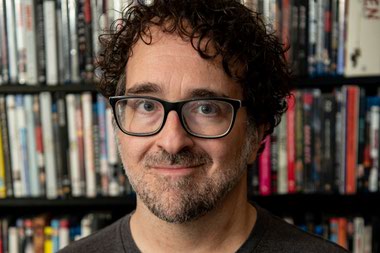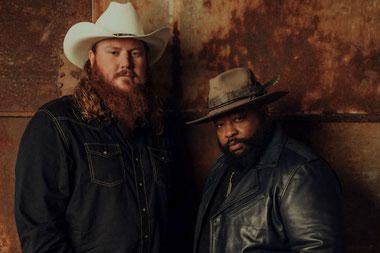Vegas always feels like a big deal, and sometimes it feels like way more than that. That happened on November 16, when a swarm of international media gathered inside Monte Carlo’s new Park Theater to welcome the Strip’s newest resident performer, Ricky Martin.
“I was offered a residency some years ago, but every time I thought of being in one place I thought of Broadway,” Martin said, after a hype video reminded us of his international stardom—he regularly sells out shows at venues that hold far more than the 5,200 seated capacity at this new room, which opens December 17. “The timing now is perfect. I’m with a company that is helping me to put on an amazing show. It’s going to be a very powerful production.”
On April 5, Martin, who first performed in Las Vegas with Menudo in 1984—long before exploding in popularity as a solo artist with 1999 hit “Livin’ la Vida Loca”—will premiere a production helmed by Jamie King, who has spearheaded tours for Madonna, Britney Spears and Rihanna and wrote and directed Cirque du Soleil’s Michael Jackson One show at Mandalay Bay.
That qualifies as big news, especially since it finds a brand new venue adding to its stable of previously announced residents, Bruno Mars and Cher. Those names are set to join the parade of music residents on the Strip—in productions built around pop stars Britney Spears, Jennifer Lopez, Lionel Richie and new addition the Backstreet Boys at Planet Hollywood’s Axis theater and around legacy acts like Celine Dion, Elton John and Rod Stewart at the Colosseum at Caesars Palace.
With those headliners and others playing Vegas so often, the city’s old Entertainment Capital of the World title feels more apt than ever. “These residencies have become the dominant form of entertainment in Las Vegas,” Live Nation Las Vegas president Kurt Melien says. “There are lots of other great productions and options for visitors, but the rise of these shows is center stage.”
Live Nation produces and books many of Las Vegas’ resident productions. Melien says it’s all about growing the market today. “You used to have one major resident theater in the Colosseum, then Axis came along and it became clear there was greater demand. You’d have three or four resident artists a few years ago, then that doubled, then tripled. These shows aren’t cannibalizing each other; they’re all growing the pot.”
The sheer volume of major concerts taking place on any given Vegas night might suddenly seem surprising, considering the Strip has never been known as the live entertainment capital of the world.
“It’s not the biggest market in the world, but on any [weekend] there are more major entertainment choices than in LA or New York or anywhere else,” says Pollstar founder and Editor-in-Chief Gary Bongiovanni. “It has managed to become a regular stop on virtually every major tour, including some that may skip larger markets but still play Vegas. Whether it’s the Stones or Madonna, everybody plays Vegas, and that hasn’t always been the case.”
The concept of the Vegas residency isn’t new. Elvis, the Rat Pack, Liberace and Wayne Newton were among the original performers who helped put Las Vegas’ entertainment scene on the map. But in the modern era, the phenomenon of musical production shows constructed for an established star or group has expanded widely in a short time, and in an organic fashion.
The boom began with Celine Dion’s A New Day at the Colosseum in 2003, a project created specifically for its star. “Celine and [husband] René [Angélil] decided she could do a spectacle here and come off the road for a number of years,” says John Nelson, senior vice president of AEG Las Vegas, which produced that show. “Caesars loved the idea and signed on to build the theater, a $95 million project.”
Franco Dragone had left Cirque to create A New Day, signing on to produce it, too. When that process began, Cirque’s productions dominated the Strip, using showrooms that held about 1,800 bodies; the economics of a resident show for a headlining superstar necessitated a theater twice that size, since they could only stage one show each night, Nelson says. Celine signed on to do 200 shows per year for three years, and Caesars built the Colosseum “without giving much thought to her sharing it with others, except the few weeks a year she was off.”
Later in A New Day’s run, the schedule scaled back to some 160 shows a year, creating an opening for the Colosseum’s first co-resident, Elton John. After five years, Celine took a break to go on tour, and the Caesars venue, which holds about 4,300, began rotating its stars—a cycle that has included Bette Midler, Cher, Rod Stewart, Shania Twain, Reba McEntire and Brooks & Dunn, and Mariah Carey, who will end her two-year gig in 2017, opening up a spot for a new artist.
Celine’s show was legendarily successful from the start, but “almost everybody in the business thought it was a ridiculous idea and would be a huge failure,” Nelson says. “People didn’t believe in it, because it hadn’t been done for a long time, or ever at that scale, that number of shows per year. The general consensus was, it was too much supply of one artist.”
But those naysayers hadn’t considered the nature of Celine’s worldwide stardom, he explains. “She is an absolutely unique artist in that she has these monstrous careers not just in the English-speaking world, but in the French-speaking world, countries where she’s as big or a bigger star.”
After superstars with global audiences became the standard, Britney Spears came to town to shake up the formula further. “That was a groundbreaking event,” Live Nation’s Melien says. “What followed Britney at Axis and the Colosseum was going out and getting younger artists and a wider span of genres that would mirror the changing demographic of Vegas. Now we’ve got everything from Pitbull to Brooks & Dunn. The demographic is more diverse than ever.”
“It’s not the Lawrence Welk or Glenn Miller Orchestra coming to casinos anymore. These are younger people with more diverse, more current tastes,” says Pollstar’s Bongiovanni. “The people running the casinos are younger now, too, and they’re not scared of this music.”
With its first three Park Theater residents, MGM already has plenty of ground covered in terms of audience and artistry, and that was the goal. The new venue gives MGM a resident-oriented room with which to compete with Caesars, which owns Axis and the Colosseum. “Bruno [Mars] is the quintessential pop star right now, and you can’t ask for more than that,” says Chris Baldizan, MGM Senior Vice President of Entertainment & Sports. “Cher has been there, and though she’s not in the mainstream as much as she once was, she has a way of always reinventing herself. And Ricky [Martin] is so well-known worldwide musically and appreciated artistically and as a humanitarian, he’s an international superstar. We feel like we’re off to a great start.”
MGM also has a secret weapon when it comes to luring big-name acts: its other new showroom, the Theater at MGM National Harbor in Maryland, a new resort that opens this week. All three Park residents will also perform there, a bonus that allows MGM to offer artists more dates and exposure on both coasts.
“We are looking at what really defines a residency. For us, it’s not 50 or 60 dates a year; it’s having the relationship,” Baldizan says. “It could be three or six or nine dates. You can be here and National Harbor or just here. And once artists see this venue, we’re going to get more calls from people saying, ‘We’d like to look at that.’ We have to be careful not to over-book, but we want to have 200 shows a year, resident shows and one-offs [at Park Theater].”
Vegas’ resident phenomenon is still rising, limited only by the number of weeks in a year and the number of stages on or near the Strip. The House of Blues at Mandalay Bay has found stability and success with residencies from Carlos Santana and Billy Idol. George Strait plays exclusively at T-Mobile Arena. The Joint at the Hard Rock Hotel has hosted runs from rock bands like Guns N’ Roses, Def Leppard, Kiss and the just-announced Journey. And the Venetian Theatre continues to dabble in mini-residencies—from John Fogerty to Diana Ross to Willie Nelson. (The Venetian could potentially bring more arena-sized residencies to its planned, 17,500-seat off-Strip collaboration with Azoff MSG Entertainment, announced earlier this year.)
“The resident boom seems like it’s in a good place right now,” Nelson says. “Visitation to Vegas is growing at a fairly regular pace, but the supply of seats available for these world-recognized artists is increasing much quicker than that. It’s kind of a reflection of what’s happening in music in general. ... Not to get too philosophical, but it’s similar to the explosion of the distribution of music. There are so many more choices now, as a listener or a spectator.”











